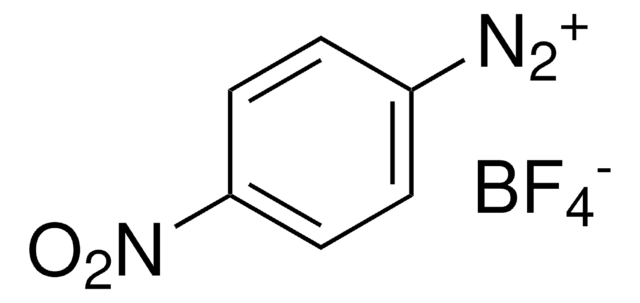283088
4-Methoxybenzenediazonium tetrafluoroborate
98%
Sinónimos:
4-Methoxyphenyldiazonium tetrafluoroborate, p-Anisyldiazonium tetrafluoroborate, p-Methoxybenzenediazonium fluoborate (6CI), p-Methoxybenzenediazonium fluoroborate, p-Methoxybenzenediazonium tetrafluoroborate (7CI), p-Methoxybenzenediazonium tetrafluoroborate(1-), p-Methoxyphenyldiazonium tetrafluoroborate
About This Item
Productos recomendados
Análisis
98%
formulario
solid
mp
142-144 °C (lit.)
temp. de almacenamiento
−20°C
cadena SMILES
F[B-](F)(F)F.COc1ccc(cc1)[N+]#N
InChI
1S/C7H7N2O.BF4/c1-10-7-4-2-6(9-8)3-5-7;2-1(3,4)5/h2-5H,1H3;/q+1;-1
Clave InChI
BYGWNWAFXUPZHI-UHFFFAOYSA-N
¿Está buscando productos similares? Visita Guía de comparación de productos
Descripción general
Aplicación
Palabra de señalización
Danger
Frases de peligro
Consejos de prudencia
Clasificaciones de peligro
Eye Dam. 1 - Skin Corr. 1B
Código de clase de almacenamiento
8A - Combustible corrosive hazardous materials
Clase de riesgo para el agua (WGK)
WGK 3
Punto de inflamabilidad (°F)
Not applicable
Punto de inflamabilidad (°C)
Not applicable
Equipo de protección personal
Eyeshields, Faceshields, Gloves, type P3 (EN 143) respirator cartridges
Elija entre una de las versiones más recientes:
¿Ya tiene este producto?
Encuentre la documentación para los productos que ha comprado recientemente en la Biblioteca de documentos.
Nuestro equipo de científicos tiene experiencia en todas las áreas de investigación: Ciencias de la vida, Ciencia de los materiales, Síntesis química, Cromatografía, Analítica y muchas otras.
Póngase en contacto con el Servicio técnico









